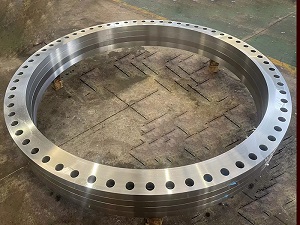No More Mistakes with Flour Mill Machine Manufacturer
Mar 11 2023

Flanges are pervasive in piping systems. They serve as mechanical joints that connect pipes, valves, pumps, and other equipment. When it comes to waterworks and utility systems, flanges play a crucial role. Especially, the AWWA flanges ensure reliability, safety, and compatibility across diverse applications.
AWWA flanges are specially designed for water transmission and distribution, wastewater treatment, and related industrial processes, distinguishing them from flanges designed for higher-pressure or more corrosive applications found in oil and gas or chemical industries. These flanges help maintain the reliability of water pipelines, preventing leaks, and ensuring the efficient and safe delivery of potable water and the effective management of wastewater.
This article will explain the various classes of AWWA flange such as B, D, E, and F and provide a detailed breakdown of their characteristics, pressure ratings, material considerations, and typical applications.
AWWA Flange Classes: A Detailed Breakdown
The AWWA C207 standard comes in four classes, namely Class B, Class D, Class E, and Class F. These classes are generally distinguished by their pressure ratings and corresponding dimensions.
Class B: Low-Pressure Use
Class B flanges represent the entry-level for AWWA flanges. These flanges are used where pressure is relatively low.
Pressure Rating: Typically rated for 85 psi pressure.
Dimensions: They generally feature thinner profiles and smaller bolt circles compared to higher-pressure classes.
Material Considerations: Commonly manufactured from carbon steel due to its cost-effectiveness and sufficient strength for low-pressure applications. Stainless steel flanges are also available. They are frequently used in municipal water systems.
Bolt Pattern Differences: Class B flanges will have fewer and/or smaller diameter bolts.
Common Application
Light-duty water systems
Drainage systems where pressure is minimal
Low-pressure industrial water lines
Certain non-potable water applications where pressure surges are not anticipated.
Class D: Standard Pressure Class for Water Pipelines
Class D flanges represent the most widely used standard pressure class in water treatment and distribution.
Pressure Rating: Standard pressure class for water pipelines, rated for 150–175 psi working pressure. They are suitable for the majority of municipal water transmission and distribution lines.
Dimensions: These flanges are thicker and have larger bolt circles and more robust bolt patterns than Class B flanges.
Material Considerations: Primarily carbon steel is used for its strength and widespread availability. For corrosive environments or specific applications requiring enhanced durability, stainless steel flanges may be specified.
Bolt Pattern Differences: They feature a greater number of bolts or larger diameter bolts to handle the higher working pressure.
Common Application
Municipal water transmission mains
Water distribution networks within cities and towns
Water treatment plant piping
Fire protection systems
Industrial water supply lines
Class E: Higher Pressure Applications
Class E flanges have greater pressure handling capability, which is ideal for more demanding conditions within water and wastewater infrastructure.
Pressure Rating: Class E C207 has an even higher pressure rating of 275 psi.
Dimensions: These flanges are thicker and have larger bolt circles and often more bolts or larger diameter bolts than Class D flanges.
Material Considerations: Carbon steel is the primary material, offering the necessary strength. Higher-grade carbon steels or stainless steel are used for specialized applications or environments.
Bolt Pattern Differences: They feature either a higher bolt count, larger bolt diameters, or both.
Common Application
Elevated water storage tank connections
High-pressure pump discharge lines
Specific industrial water applications, etc
Class F: Heavy-Duty Flanges
Class F flanges represent the heavy-duty option within the AWWA C207 standard. They are specially designed for the most demanding pressure applications in waterworks service.
Pressure Rating: Class F has a maximum rating of 300 psi.
Dimensions: They are the thickest and most robust classes. Their dimensions, including outside diameter, bolt circle, and bolt hole size, are maximized to ensure structural integrity at 300 psi.
Material Considerations: High-strength carbon steel is standard for Class F flanges due to the rigorous pressure demands.
Bolt Pattern Differences: They feature the largest number of bolts and/or the largest bolt diameters to withstand extreme pressures and prevent joint separation.
Common Application
High-pressure raw water intake lines
Pump stations with very high discharge pressures
Specific industrial applications
Connections to large-diameter valves and equipment
Critical pipeline sections
Tips for Selecting the Right Flange Class
System Operating Pressure
Always look for a flange class with an appropriate pressure rating that exceeds the maximum expected operating pressure of the system, including potential surge pressures.
System Design Temperature
Remember extreme temperatures can affect material strength. That’s why it is better to consult a professional for material specifications if the system operates at elevated or very low temperatures.
Pipe Material and Wall Thickness
Make sure the flange is compatible with the pipe material and its pressure rating.
Fluid Type and Corrosivity
For highly corrosive fluids, consider alternative materials like stainless steel or corrosion-resistant coatings, even if the base flange is carbon steel.
Environmental Conditions
Exposure to corrosive atmospheres can influence material selection for durability.
Installation and Maintenance
Consider easy installation and future maintenance.
Regulatory Requirements and Local Codes
Follow the local building codes, municipal standards, and any specific regulatory requirements for water and wastewater infrastructure.
Future Expansion or Pressure Upgrades
Is there any possibility of increasing system pressure in the future? Choose a higher flange class upfront to avoid costly retrofits and downtime.
Cost-Benefit Analysis
Set your budget based on the balance of safety and longevity of the flanges.
Conclusion
The reliability of municipal and industrial piping systems, involved in water and wastewater management, relies on the correct selection and application of flanges. AWWA flange classes B, D, E, and F provide a standardized framework. By understanding the above-mentioned information, you can make the right decision.
Looking for a certified AWWA flange supplier to ensure safety, compliance, and durability? At Sumitec, we are dedicated to your project’s success. We offer fast quotations, thorough compliance documentation, and responsive after-sales support.
Social Media Marketing Strategies for Beginners
Mar 14 2023
(0) Comments